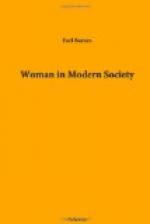[29] See The Americans, by HUGO MUeNSTERBERG, pp. 558-589. Boston: Houghton, Mifflin & Co., 1901.
Personal observation must always be colored by prejudices and prepossessions, but my own have been so wide, and so uniformly in one direction, that it seems justifiable to report them.
* * * * *
For a quarter of a century I have been working in schools or with teachers, and my personal observations all agree with the above characterization. I have spent five years in Cornell University, New York; one year in Zurich University in Switzerland; two years in the State University of Indiana and seven years in Stanford University in California. These institutions are widely distributed; they were all fully co-educational; and they each had a wide range of elective studies. In all of them, class-rooms devoted to literature and modern languages had a large attendance of women, while lecture-rooms and laboratories devoted to abstract science were almost deserted by them. This could not have been due to commercial considerations, for many of these women were facing teaching; and during all this time the demand for women who could teach science has been much greater than for women who could teach literature.
In my work with teachers, both in the classroom and in the field, I have carried out many inductive, quantitative studies, based on measurements or returns from large numbers of children. I have never found women teachers taking up and carrying out this kind of work with any such enthusiasm as men apply to it, though it lies at the base of their professional life.
Institutional generalizations seem all to point in this same direction. For instance, the Girls’ Evening High School in Philadelphia is managed by one of the best known scientific women in the country, Dr. L.L.W. Wilson, head of the biological department of the Philadelphia Normal School. With a thousand girls of high school grade, under the leadership of a scientific woman, the only science courses given in the school are those in domestic science. The reason is that the girls, most of them not being candidates for a degree, will not take up science work, though they form strong classes in literature and languages.
If, from such general facts of observation, one turns to exact comparisons, where quantities can be measured, the results are all the same. Of students enrolled in classical departments of universities, colleges and technical schools reporting to the United States Bureau of Education, in 1910, 36.5% were women, while of those enrolled in general science courses, but 17.2% were women. In 1,511 public and private high schools and seminaries, reporting to the Bureau of Education in 1909-1910, a larger percentage of boys than of girls was enrolled in algebra, geometry, trigonometry, physics, chemistry, physical geography, civil government and rhetoric, which is a scientific study of language. A larger proportion of girls enrolled in Latin, French, German, English literature and history, and there was a slightly greater enrollment of girls in botany, zoology and physiology.




